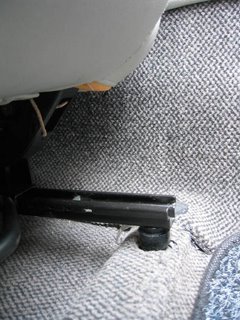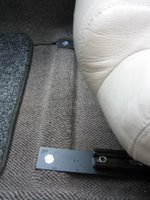To compensate for this, two solutions were implemented in my car. The first is mentioned in my post below, where a custom made steering column spacer hub was installed. After locating a design drawing for a similar item for a Porsche 911 on the web, the Maserati specialist from whom I purchased the car promptly turned the drawing into the real thing. Coming from a background of car restoration, he has a number of useful contacts, one of which was able to machine the spacer. As a nice finishing touch, the spacer was then powder coated in matt black and once fitted it looks like an OEM part. And the nicest thing was... it was free of charge; it was negotiated into the price of the car.
Subsequently, I learnt of a similar item on Enrico's Maserati Pages in the "Can you help...?" section, so if you're after something similar then try Googling this site (or try this link and scroll down the page to the bit about Nardi).
 The picture on the left here is of a seat rail (this one is one of the front passenger seat rails) which attach the seat to the floor of the car and enable it to slide forward and backward to suite the occupant.
The picture on the left here is of a seat rail (this one is one of the front passenger seat rails) which attach the seat to the floor of the car and enable it to slide forward and backward to suite the occupant.Next was a trick I'd seen in an old Mini that a tall friend of mine used to have when I was at school. To increase the leg room (and make pressing in the heavy clutch on the Ghibli a little less fatiguing) a pair of seat rail extensions were made, again by the very helpful Maserati specialist from whom I purchased the car.
As you can see from the picture on the left, the original seat rails have a 10-15 mm spacer between the seat and the floor. This may not sound like much, but may be enough to prevent a tall driver from getting a stiff neck on a long drive by not having to crouch down in the driver's seat!
 So, the seat was temporarily removed from the car, the spacer removed and a strip (30 mm width approximately) of decent guage, powder coated steel bolted to the floor in place of the original rails. This strip has pre-drilled holes in it, appropriately positioned to enable the seat rails to be bolted onto it, as illustrated in the picture on the right. The seat rails are now located about 60-70 mm further back than original, and about 20 mm lower. This, coupled with the steering column extension has made the driving position far better than original (for me) and enabled me to drive considerable distances in comfort (such as from the Netherlands to Switzerland, although admittedly the wife helped out!).
So, the seat was temporarily removed from the car, the spacer removed and a strip (30 mm width approximately) of decent guage, powder coated steel bolted to the floor in place of the original rails. This strip has pre-drilled holes in it, appropriately positioned to enable the seat rails to be bolted onto it, as illustrated in the picture on the right. The seat rails are now located about 60-70 mm further back than original, and about 20 mm lower. This, coupled with the steering column extension has made the driving position far better than original (for me) and enabled me to drive considerable distances in comfort (such as from the Netherlands to Switzerland, although admittedly the wife helped out!).The only negative aspects of these modifications are that the steering column controls (the stalks for the lights and wind screen wipers) require fully extended fingers to reach them with hands on the steering wheel and there is no (absolutely non) room behind the drivers seat when I'm driving the car, as illustrated in the picture below. However, it's arguable that there's enough space in the back for adults regardless and in my mind, the advantages of the modification far outweight the minor disadvantages. And, unlike my school friends Mini, I have plenty of room to engage 3rd (5th on the Ghibli) gear without being obstructed by my knees!

No comments:
Post a Comment